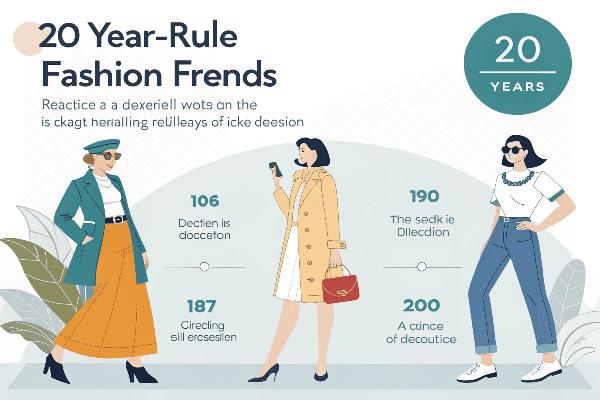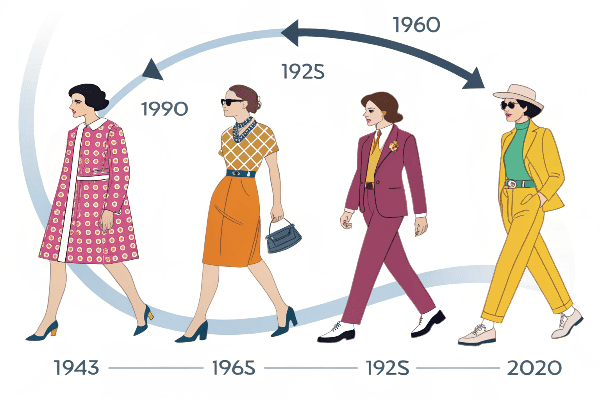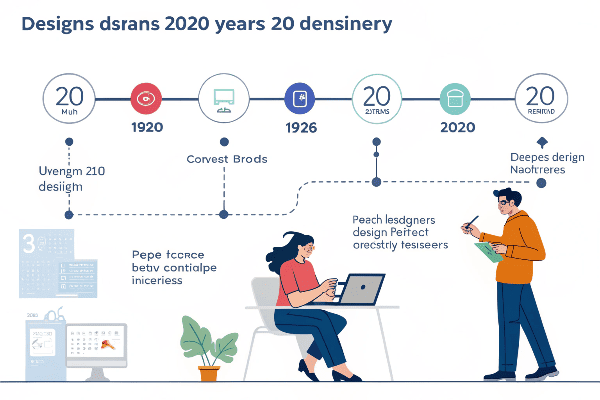
Fashion is a cycle. What’s “out” today often makes a comeback tomorrow. That’s where the 20-year rule comes in—a pattern where styles resurface roughly two decades after their peak. So what does that mean for today’s trends?
The 20-year rule in fashion refers to the idea that styles and aesthetics from 20 years ago become trendy again, often with a modern twist. For example, 2000s Y2K fashion is resurging in the 2020s[^1].
I’ve seen this cycle play out again and again. Just when I think a look is gone forever—low-rise jeans, baby tees, chokers—it comes right back with Gen Z leading the charge.
Table of Contents
- Why do fashion trends repeat every 20 years?
- What 2000s trends are back in style now?
- Is the 2010s fashion next in line?
- Can older trends skip the 20-year cycle?
- How can brands and designers use the 20-year rule?
- Conclusion
Why do fashion trends repeat every 20 years?
It’s not just nostalgia—there’s logic behind the cycle.
Trends repeat every 20 years because that’s when a new generation, unfamiliar with the original trend, discovers it and reinterprets it as something fresh.

How the 20-year rule works
| Time Period | Trend Cycle | Modern Rebirth |
|---|---|---|
| 1980s | Power suits, neon, aerobics | Seen again in 2000s |
| 1990s | Grunge, slip dresses, mom jeans | Revived in 2010s |
| 2000s | Low-rise, crop tops, butterfly clips | Dominating the 2020s |
👉 Read more on fashion’s cyclical nature
What 2000s trends are back in style now?
Welcome to the Y2K revival.
Many 2000s trends—like velour tracksuits, cargo pants, baby tees, and micro shoulder bags—are back thanks to TikTok and celebrity nostalgia.
Popular Y2K items that returned
- Low-rise jeans – Worn by Gen Z with crop tops or oversized hoodies
- Tiny bags – Reintroduced by brands like Jacquemus and Prada
- Logo mania – Seen on shirts, caps, and pants across fast fashion
- Butterfly clips & rhinestones – Retro accessories with a playful twist
Is the 2010s fashion next in line?
Yes—and it’s already beginning.
As we approach the 2030s, early signs show that fashion from the 2010s (like normcore, statement sneakers, and minimalist basics) will return in updated forms.
What to expect from the 2010s revival
| Original 2010s Trend | Predicted Revival Style |
|---|---|
| Skinny jeans | Slim-straight cuts with stretch |
| Minimalist fashion | Elevated basics and muted palettes |
| Hipster aesthetic | Flannel, beanies, thick-frame glasses |
Can older trends skip the 20-year cycle?
Sometimes, yes.
While the 20-year rule is common, some trends come back even faster—or skip decades—depending on cultural shifts, celebrity influence, or social media.
Examples:
- 2000s ballet flats returned in under 15 years
- ’70s flare pants skipped the 1990s but exploded in the 2020s
- Corsets have re-emerged repeatedly—Victorian era, 90s goth, and now TikTok-core
👉 How TikTok accelerated the fashion cycle
How can brands and designers use the 20-year rule?
It’s a goldmine if you plan ahead.
Designers can use the 20-year rule to predict trends, rework retro styles, and build collections that feel both nostalgic and modern.

Strategy tips for leveraging the trend cycle
| Action | Why It Works |
|---|---|
| Reimagine old bestsellers | Familiarity + freshness = high appeal |
| Collaborate with vintage creators | Boosts authenticity and reach |
| Monitor TikTok aesthetics | Spot revivals before they hit mainstream |
👉 How nostalgia drives fashion revenue
Conclusion
The 20-year rule in fashion reveals how trends evolve in cycles. From Y2K styles flooding back in the 2020s to early signs of 2010s revival, understanding this pattern helps both brands and individuals stay ahead. Fashion repeats—but with a new attitude each time.
[^1]: The “20-year rule” has been discussed across fashion think tanks and media outlets including Vogue and The Cut.
